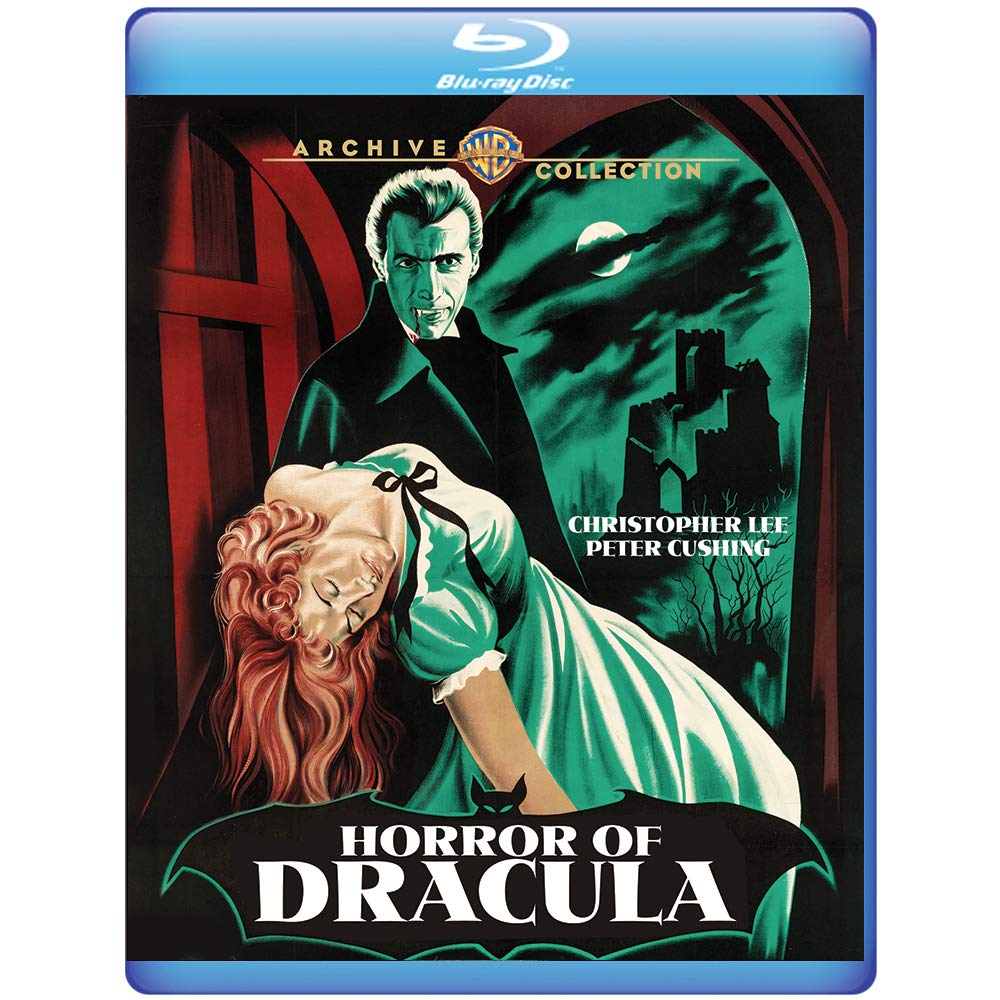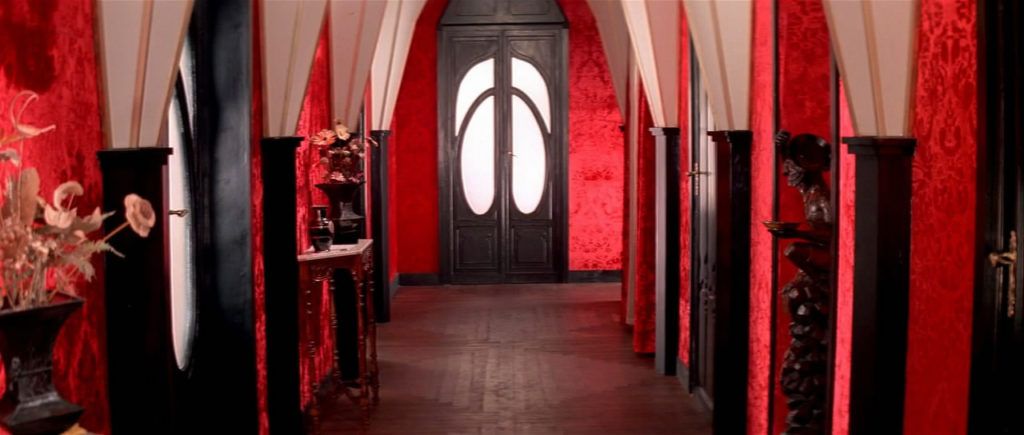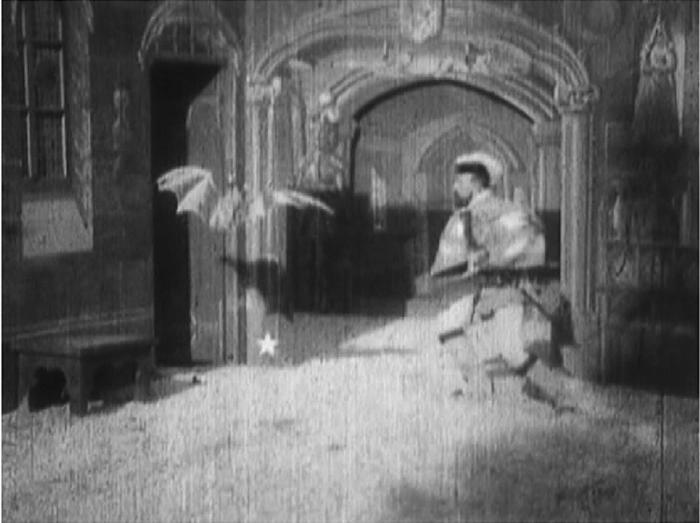If you are using Chrome, click the red hand button at the top right of the screen:

Then select: Don't run on pages on this site
If you do it correctly, the red hand will turn to green and you will no longer see this message.
I'm talking about another Dracula's version filmed at 1931.

This is my file:
Dracula
Year: 1931
Country: United Kingdom
Genre: Horror. Vampires. Dracula.
Director: Tod Browning, Karl Freund
Screenplay: Garrett Fort, Dudley Murphy (Novel: Bram Stocker)
Cast: Bela Lugosi, Helen Chandler, David Manners, Dwight Frye, Edward Van Sloan, Herbert Bunston, Frances Dade, Joan Standing, Charles K. Gerrard, Carla Laemmle
Production company: Universal Pictures
Cinematography: Karl Freund (B&W)
Music: Various (Classical music: Richard Wagner, Peter Tchaikovsky)
Running time: 75'.
Awards: (not listed)
Synopsis: One of the first versions of the mythical vampire made by Universal (production company specialized in horror films). Count Dracula leaves the Carpathian Mountains and moves to the West, taking an accountant as a servant. Once settled, he falls in love with a young woman who is already betrothed. He begins to visit her at night and drinks her blood little by little to make her his wife. But the young woman's discomfort alerts her family, who seek the help of Dr. Van Helsing. (taked from Filmaffinity web)
Personal impression: a delightful film in which, given its date of shooting -remember that cinema had just gone from silent to sound- allows us to delight us with magnificent actors and actresses specialized in expressing much with few words. Could Brad Pitt or, excuse me, Antonio Banderas, achieve the terrifyingly Bela Lugosi's vampiric expression? I doubt it. For the rest, it is a feat to summarize in 75 minutes Bram Stocker's novel being relatively faithful, except for script obligations. Recommended.
I confess I adore Hammer Film Productions. Despite the old-fashined air vampire films, that today can make us laugh, I recognice the value of all 1950's low-cost films but made with a lot of imagination.
Hammer Film Productions Ltd. is a British film production company based in London. Founded in 1934, the company is best known for a series of Gothic horror and fantasy films made from the mid-1950s until the 1970s. Many of these involve classic horror characters such as Baron Victor Frankenstein, Count Dracula, and the Mummy, which Hammer reintroduced to audiences by filming them in vivid colour for the first time.
During its most successful years, Hammer dominated the horror film market, enjoying worldwide distribution and considerable financial success. This success was, in part, due to its distribution partnerships with American companies. During the late 1960s and 1970s, the saturation of the horror film market by competitors and the loss of American funding forced changes to the previously lucrative Hammer formula with varying degrees of success. The company eventually ceased production in the mid-1980s. In 2000, the studio was bought by a consortium including advertising executive and art collector Charles Saatchi and publishing millionaires Neil Mendoza and William Sieghart. The company announced plans to begin making films again, but none were produced. Since then, Hammer has produced several films, including Beyond the Rave (2008), Let Me In (2010), The Resident (2011), The Woman in Black (2012), The Quiet Ones (2014), and The Lodge (2019).
Anyway, I'll always remember those old films featured by the great Peter Cushing, Christopher Lee, Veronica Carlson, Ingrid Pitt or Ralph Bates.
Today, I'd like to talk about one of the Hammer production: Horror of Dracula (1958)

One year before, and with a final budget of £81,412, Dracula began principal photography on 11 November 1957. Peter Cushing had top-billing as Doctor Van Helsing, whilst Christopher Lee starred as Count Dracula, with direction by Terence Fisher and a set design by Bernard Robinson that was radically different from the Universal Company adaptation; it was so radical, in fact, that Hammer executives considered paying him off and finding another designer.
Dracula was an enormous success, breaking box-office records in the U.K., the U.S. (where it was released as Horror of Dracula), Canada, and across the world. Establishing the fanged vampire in popular culture, Lee also introduced a dark, brooding sexuality to the character. The academic Christopher Frayling writes, “Dracula introduced fangs, red contact lenses, décolletage, ready-prepared wooden stakes and – in the celebrated credits sequence – blood being spattered from off-screen over the Count's coffin.”The film magazine Empire ranked Lee's portrayal as Dracula the 7th Greatest Horror Movie Character of All Time. 1960 saw the release of the first in a long line of sequels, The Brides of Dracula, with Cushing returning to the role of Van Helsing, though Lee did not play Dracula again until Dracula: Prince of Darkness, released in 1966.
Personal critics:
The film is a reinterpretation of Stoker's classic novel "Dracula." In fact, it adopts all the characters in the novel but modifies them. Thus, the Lucy of the novel (fiancée of Arthur Holmwood) is not the Lucy of the film (wife of Jonathan Harker), the Mina of the novel (fiancée of Jonathan Harker) is not the Mina of the film (wife of Arthur Holmwood )... and so. Dr. Van Helsing has the same role, although the film does not explain why he is interested in eliminating Dracula, his knowledge of vampires, or what leads him to appear on the scene. We would say that it is an adaptation of Stoker's novel with a free use of the characters created by him. The character of Dracula is maintained and developed quite well, although if someone wants to know better the legend, I would definitely recommend to read the Stoker's novel.
It is said this is a horror movie but... horror, what we consider horror, well I cannot appreciate it. No uncunny. In other way, the eroticism, that traditionally accompanies the figure of the vampire, is also out. But what can we say? We are in the 50's and the Code of Morality predominates in the arts... For the rest, being a 1958 film, we cannot fail to recognize its decorations and achieved effects.
Resume file:
Original title: Dracula (Horror of Dracula at USA and in present European Blue-Ray re-editions)
Year: 1958
Running time: 82 min.
Country: United Kingdom
Director: Terence Fisher
Screenwriter: Jimmy Sangster. (Play: Bram Stoker)
Music: James Bernard
Cinematography: Jack Asher
Cast: Christopher Lee, Peter Cushing, Michael Gough, Melissa Stribling, Valerie Gaunt, Carol Marsh, Olga Dickie, John Van Eyssen, Janina Faye, Barbara Archer, Charles Lloyd Pack
Producer: Hammer Productions
Genre; Horror | Vampires
Synopsis: (Filmaffinity): Posing as a librarian, erstwhile vampire hunter Jonathan Harker travels to Castle Dracula where he is welcomed by the courtly Count Dracula. Harker attempts to kill Dracula and eliminate the vampire menace that Dracula spreads but the sun sets before he can do so. His body and diary are found by his friend Dr Van Helsing, who stakes him and takes the sad news on to Jonathan’s fiancée Lucy Holmwood. But there Van Helsing finds that Lucy has become Dracula’s prey. Joined by her brother Arthur, Van Helsing begins a search for Dracula, to stake and kill him before Lucy is fully claimed as a vampire.
Do you like the Dario Argento films? Personally, I am impressed by the intensity of this Italian director films. Specifically, in Suspiria, not only he manages to create a disturbing atmosphere with the story, but he also takes care of every detail to achieve it: music, fantastic sets, light, water symbology in its most distressing state (storms, downpours, sinks). Moreover, the decoration of the house is incredibly original: the color of the walls, the coffered ceilings, the staircase, the door-windows... everything gives the impression of a gothic environment, but not in the vampire style but... gothic-modern, - if that word exists-.

To critice something, I would have liked the director had developed the question of the witch in a more wider way, but also that treatment, which leaves a thousand questions in the air, achieves that disturbing atmosphere. Highly recommended, in two words.
Resume file:
Original title: Suspiria
Year: 1977
Running time: 101 min.
Country: Italy
Director: Dario Argento
Screenwriter: Daria Nicolodi, Dario Argento. Book: Thomas De Quincey
Music: Goblin, Dario Argento, Máximo Morante, Fabio Pignatelli, Claudio Simonetti
Cast: Jessica Harper, Stefania Casini, Flavio Bucci, Udo Kier, Miguel Bosé, Rudolf Schündler, Joan Bennett, Alida Valli, Barbara Magnolfi, Susanna Javicoli, Eva Axén, Margherita Horowitz, Fulvio Mingozzi, Franca Scagnetti, Renato Scarpa, Renata Zamengo
Producer: Seda Spettacoli
Genre: Horror. Supernatural. Haunted Houses. Witchcraft. Cult Movie. Giallo
Considered the first horror movie, and arguably the first vampire movie, The Devil's Castle (Le manoir du diable) runs over 3 minutes, an astonishing length for the time. The movie has been known by a variety of alternate names including The Devil's Manor, The Manor of the Devil, The House of the Devil, and The Haunted Castle. The latter is often incorrectly attributed to this film, but "The Haunted Castle" is actually the name of a different movie by Méliès, filmed 1 year later, and viewable here: https://youtu.be/OBArxsdF2rs

Georges Méliès’ Le manoir du diable (1896) is a key example of the horror-themed film in early cinema. Its tone is more serious than many of his subsequent films, which generally focussed on humor, and its visual content presents a number of tropes later associated with the horror film genre, among them devils, ghosts, and witches inside a haunted castle. Believed lost for decades, a copy resurfaced in 1988 at the Ngā Taonga Sound & Vision archive, appearing on the Flicker Alley DVD Georges Méliès Encore in 2010.
If the use of the cross is one reason that modern viewers have mistaken the devil character for being a vampire, the other is film’s opening, in which a large bat transforms into Mephistopheles. Here again, the emphasis in vampire literature and films of the post-1896 era have clouded the ability for modern viewers to read The Devil’s Castle as it was intended. Indeed, even though he acknowledges the character is Mephistopheles and not a vampire, Stephen Prince (2004) still refers to the prop as a “vampire bat”, when there is no historical or textual reason to suggest the bat is or was specifically meant to be a vampire bat.
Satan is not a vampire, but prior to 1896 there is a lengthy history that gives him demonic wings or even likens him to a bat. It is important to recall Ephesians 2:2, which describes Satan as the “prince of the power of the air.” To enumerate the sheer volume of artwork over the centuries that depicts devils and demons as having bat-like wings and talons would be difficult. Famous examples include Botticelli’s and Doré’s illustrations for Dante’s Inferno, as well as Doré’s engravings for Milton’s Paradise Lost. The same is true in late nineteenth-century visual culture, including in many French “diablerie” stereographs.
Anyway, enjoy it!
COMMENTS
-